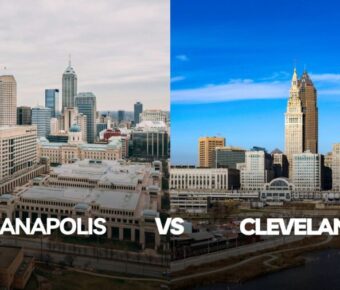
Pienza vs Volterra: Which Hidden Tuscan Gem Offers the Most Authentic Italian Experience?
Nestled in the rolling hills of Tuscany, Pienza and Volterra offer two distinct flavors of Italian charm. These hilltop towns attract visitors seeking authentic experiences away from the tourist crowds of Florence and Rome. Pienza stands out for its perfectly preserved Renaissance architecture and sweeping Val d’Orcia views, while Volterra captivates with its Etruscan roots and medieval atmosphere.
Pienza shines as Pope Pius II envisioned the ideal Renaissance city, featuring uniform architectural design and celebrated pecorino cheese. Volterra keeps a lower profile despite its Twilight fame, rewarding visitors with ancient walls, winding streets, and a renowned alabaster crafting tradition.
Both towns give travelers a genuine taste of Tuscan life, with fewer tourists than popular San Gimignano. Choosing between them comes down to personal interests – Renaissance perfection in Pienza or Etruscan mystery in Volterra.
Contents
- Geographic Context
- Location in Tuscany
- Proximity to Other Towns
- Historical Significance
- Ancient Origins
- Medieval Developments
- Renaissance Influence
- Cultural Highlights
- Local Traditions
- Gastronomy
- Art and Architecture
- Traveler’s Experience
- Accommodation Options
- Culinary Tours
- Walking and Exploration
- Sustainable Tourism
- Ecotourism Initiatives
- Supporting Local Economy
- Frequently Asked Questions
- What are the best driving routes from Pienza to Volterra, considering scenery and traffic?
- Are there any public transportation options, such as buses or trains, that directly connect Pienza and Volterra?
- For those looking to explore Volterra, what are some of the must-see attractions?
- When visiting Volterra, how much time should travelers allot to fully experience the town?
- Regarding accessibility, are there any restrictions for vehicles entering the historic center of Volterra?
- What are some hidden gems to look out for during a stay in Pienza?
- More Travel Guides
Geographic Context
Both Pienza and Volterra sit atop scenic Tuscan hilltops, offering visitors breathtaking views of the surrounding countryside. These historic towns stand as prime examples of strategic medieval positioning.
Location in Tuscany

Pienza nestles in the beautiful Val d’Orcia region of southern Tuscany, perched 491 meters above sea level. The town’s position provides stunning views of Monte Amiata and the rolling hills that characterize this part of the region.
Volterra rises impressively at 545 meters above sea level in the heart of the province of Pisa. The town occupies a commanding position between the Era and Cecina valleys, with its ancient walls still defining much of its hilltop boundary.
Proximity to Other Towns

Pienza makes an ideal base for exploring southern Tuscany. The town sits just 20 minutes from Montepulciano and 40 minutes from Montalcino, forming part of a popular wine-touring route.
Volterra’s location puts it within easy reach of several notable destinations. San Gimignano lies just 30 kilometers away, making it perfect for a Search Flights, Hotels & Car Hire day trip.
The medieval city of Siena can be reached in about an hour from either town, though the roads from Volterra tend to be more winding due to its position in the hillier northern territory.
Historical Significance
Both Pienza and Volterra represent different chapters in Tuscany’s rich history, each with its own remarkable path from ancient civilizations through medieval times and into the Renaissance era.
Ancient Origins

Volterra claims deeper historical roots dating back to the Etruscan period. The ancient Etruscans built this city as a major settlement in the 8th century BCE. The massive stone walls they constructed still stand today, stretching over 7 kilometers around parts of the city.
Pienza’s early history is more modest. The area was first settled as a small village called Corsignano during Roman times. It remained a quiet farming community for centuries.
The two towns show very different ancient foundations – Volterra as a powerful Etruscan capital and Pienza as a humble rural settlement. This contrast shaped their later development in profound ways.
Medieval Developments
During medieval times, Volterra grew into a bishop’s seat and important center for alabaster crafting. The town’s strategic hilltop position made it a valuable prize, leading to conflicts between rival powers.
Pienza, still known as Corsignano, remained a small feudal village. Its medieval castle and church served the local farming population. The town’s relative obscurity helped preserve its simple character.
Stone towers and fortified palaces from this era still define Volterra’s skyline. Medieval walls and gates showcase the town’s defensive needs during turbulent times.
Renaissance Influence
The Renaissance brought dramatic changes to Pienza. Pope Pius II transformed his hometown into an ideal Renaissance city in just 4 years (1459-1462). He hired architect Bernardo Rossellino to rebuild the town center with perfect Renaissance proportions.
Volterra experienced more subtle Renaissance changes. Wealthy families added elegant palaces and churches to the medieval streetscape. The town kept its ancient character while incorporating new artistic styles.
Pienza’s unified Renaissance design makes it a UNESCO World Heritage site. The perfect proportions of its central square and cathedral represent the Renaissance ideals of harmony and beauty.
Cultural Highlights
Both Pienza and Volterra preserve centuries of Italian culture through distinct customs, local foods, and stunning architecture that tell unique stories of Tuscany’s rich heritage.
Local Traditions

Volterra keeps its Etruscan roots alive with the Volterra AD 1398 festival. This medieval celebration brings the streets to life with costumed performers, traditional music, and authentic crafts from the period.
The town’s alabaster crafting tradition spans over 3,000 years. Local artisans still create beautiful pieces in workshops scattered throughout the historic center.
Pienza celebrates its pastoral heritage during the Pecorino Cheese Festival each September. Shepherds showcase traditional cheese-making methods passed down through generations.
Gastronomy

Pienza is famous for its Pecorino cheese, made from sheep’s milk using age-old techniques. The local variety has a rich, complex flavor that varies based on aging time.
Volterra’s Specialties:
- Wild boar dishes
- Truffles from nearby forests
- Local olive oils
- Traditional Tuscan soups
Pienza’s Notable Foods:
- Multiple varieties of Pecorino
- Pici pasta (hand-rolled)
- Local honey
- Cured meats
Art and Architecture
Pienza’s historic center is a masterpiece of Renaissance urban planning. The town square features the perfectly proportioned Palazzo Piccolomini and the geometric Cathedral.
Volterra’s architecture spans multiple eras:
- Etruscan walls and gates
- Roman theater ruins
- Medieval towers
- Gothic palaces
The Pinacoteca in Volterra houses precious works by Italian masters, including Signorelli’s Annunciation and Rosso Fiorentino’s striking Deposition from the Cross.
Pienza’s streets follow Renaissance ideals of harmony and proportion, creating picture-perfect views at every turn.
Traveler’s Experience
Visitors to these historic Tuscan towns can expect rich cultural experiences filled with authentic Italian charm and warm local hospitality. Each destination offers distinct ways to immerse yourself in the local lifestyle.
Accommodation Options

The rustic farmhouses near Pienza make perfect bases for exploring the Val d’Orcia region. Many cozy bed and breakfasts offer stunning views of cypress-lined hills and medieval architecture.
Volterra features converted palazzos and boutique hotels within its ancient walls. The restored medieval buildings blend historic character with modern comforts.
Both towns provide agriturismos – working farms that welcome guests. These rural stays let visitors experience authentic Tuscan country living.
Room rates tend to be 15-20% lower in Volterra compared to Pienza during peak season. The best deals appear between November and March.
Culinary Tours
Pienza stands out for its famous pecorino cheese. Local producers offer tasting tours where visitors learn traditional aging methods passed down through generations.
Volterra excels in truffle hunting experiences. Expert guides and trained dogs lead small groups through oak forests to search for these prized ingredients.
Food and wine tours in both towns include stops at family-run restaurants and wineries. Guests learn to make pasta, sample local wines, and discover regional specialties.
Walking and Exploration
Pienza’s Renaissance streets invite leisurely strolls past elegant palaces and churches. The main piazza comes alive each morning with vendors selling local crafts.
Volterra’s Etruscan walls and Roman ruins create an archaeological playground. Narrow medieval lanes lead to hidden workshops where artisans carve alabaster using ancient techniques.
The towns sit at different elevations – Volterra at 1,770 feet and Pienza at 1,500 feet. Both offer scenic walking paths with panoramic views of the rolling Tuscan countryside.
Street performances and seasonal festivals add local color to evening passeggiatas in both historic centers.
Sustainable Tourism
Both Pienza and Volterra take steps to protect their historic centers and local communities while welcoming visitors. These medieval towns balance tourism growth with environmental and cultural preservation.
Ecotourism Initiatives

Pienza leads the way with its innovative Sentiero dell’Arte e dell’Anima (Art and Soul Path), which guides tourists beyond the city walls. This helps reduce crowding in the historic center while letting visitors explore the stunning Val d’Orcia countryside.
Volterra focuses on energy-efficient lighting in its museums and archaeological sites. The town also maintains strict rules about vehicle access in its historic center to cut down on pollution.
Both towns offer guided walking tours that teach visitors about local ecosystems and the importance of preserving Tuscan heritage.
Supporting Local Economy
Small family-run shops and artisans form the backbone of both towns’ economies. In Volterra, visitors can watch alabaster craftsmen at work in their traditional workshops.
Pienza encourages tourists to shop at local cheese makers who produce the famous Pecorino di Pienza. Many shops offer tastings and demonstrations of traditional production methods.
Both towns partner with nearby farms and vineyards to promote agritourism. Visitors can stay at eco-friendly farmhouses, help with grape harvests, or learn traditional cooking methods from local families.
The towns limit large tour buses and promote smaller guided groups, which creates more meaningful interactions between visitors and residents.
Frequently Asked Questions
Tuscany’s historic towns of Pienza and Volterra each offer rich cultural experiences, ancient architecture, and stunning hilltop views. Getting between them requires some planning, but the journey itself becomes part of the adventure.
What are the best driving routes from Pienza to Volterra, considering scenery and traffic?
The most scenic route takes about 2 hours through the Tuscan countryside via SR2 and SR68. This path winds through charming villages and offers stunning views of rolling hills and cypress trees.
Take the quieter SP438 for a less crowded alternative. The road passes vineyards and olive groves, perfect for photo stops.
Are there any public transportation options, such as buses or trains, that directly connect Pienza and Volterra?
No direct public transport links these towns. You’ll need to make several transfers using regional buses through Siena.
The journey takes 4-5 hours total and requires careful planning with local bus schedules.
For those looking to explore Volterra, what are some of the must-see attractions?
The Etruscan Museum showcases ancient artifacts and tells the story of the region’s rich history. The Roman Theater ruins sit beautifully preserved just outside the city walls.
The alabaster workshops display Volterra’s famous craft tradition. Watch artisans create delicate pieces using centuries-old techniques.
The Palazzo dei Priori stands as Italy’s oldest town hall, offering guided tours of its historic chambers.
When visiting Volterra, how much time should travelers allot to fully experience the town?
A full day lets you see the main attractions and explore the medieval streets at a relaxed pace. Two days give time to visit museums and enjoy local restaurants.
Morning visits offer the best light for photography and smaller crowds at popular sites.
Regarding accessibility, are there any restrictions for vehicles entering the historic center of Volterra?
The historic center is a ZTL zone (limited traffic area). Only residents with permits can drive inside during restricted hours.
Free parking lots sit just outside the walls, a 5-10 minute walk from the main square.
The secret gardens behind Palazzo Piccolomini offer peaceful spots away from crowds. You can sample fresh pecorino in quiet back rooms at local cheese shops.
The walkway along the city walls provides spectacular Val d’Orcia views that many visitors miss.
Little-known Pieve di Corsignano church sits just outside town, featuring remarkable Romanesque architecture.



